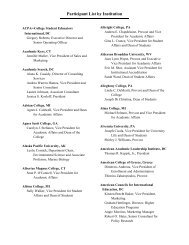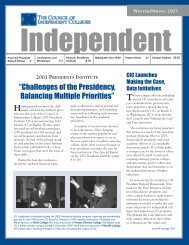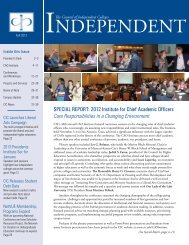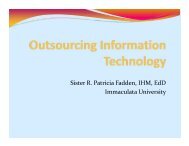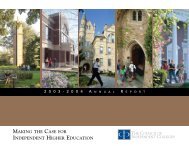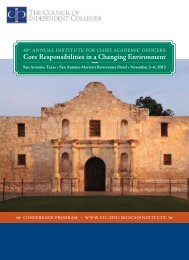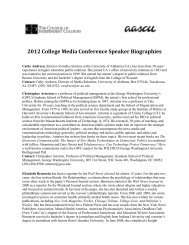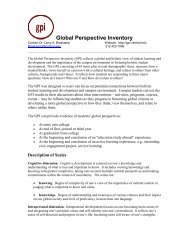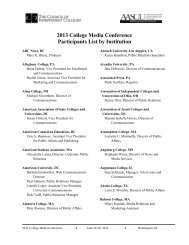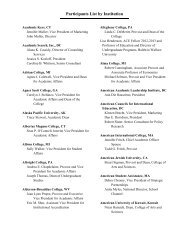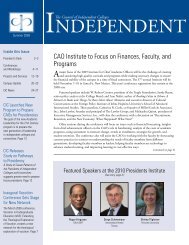Meeting the Challenge: - The Council of Independent Colleges
Meeting the Challenge: - The Council of Independent Colleges
Meeting the Challenge: - The Council of Independent Colleges
Create successful ePaper yourself
Turn your PDF publications into a flip-book with our unique Google optimized e-Paper software.
Alvin P. San<strong>of</strong>f<br />
“Agnes Scott College is a place that helps women<br />
achieve <strong>the</strong>ir highest expectations.”<br />
—Mary Brown Bullock, President, Agnes Scott College<br />
Cedar Crest has doubled in size and now enrolls <strong>the</strong> fulltime<br />
equivalent <strong>of</strong> about 1,700 students, half <strong>of</strong> whom are<br />
traditional undergraduates and <strong>the</strong> rest adult learners. Says<br />
Blaney: “Building our reputation in <strong>the</strong> sciences has brought<br />
about <strong>the</strong> growth.”<br />
Agnes Scott College in Georgia is ano<strong>the</strong>r women’s<br />
college that has enjoyed substantial growth. In <strong>the</strong> past decade<br />
undergraduate enrollment has risen from 600 to 900. Founded<br />
in 1889 as part <strong>of</strong> <strong>the</strong> Presbyterian educational movement,<br />
<strong>the</strong> college’s original mission was to educate women for <strong>the</strong><br />
betterment <strong>of</strong> <strong>the</strong>ir families and <strong>the</strong> elevation <strong>of</strong> <strong>the</strong>ir religion.<br />
It has since widened its vision dramatically. Today, many<br />
graduates enter law, medicine, and o<strong>the</strong>r pr<strong>of</strong>essions and a<br />
number pursue graduate studies. Indeed, measured by <strong>the</strong><br />
proportion <strong>of</strong> graduates who go on to earn <strong>the</strong>ir doctorates,<br />
Agnes Scott ranks in <strong>the</strong> top 10 percent nationally and in <strong>the</strong><br />
top one percent in <strong>the</strong> field <strong>of</strong> economics.<br />
President Mary Brown Bullock, herself a graduate <strong>of</strong><br />
Agnes Scott, describes <strong>the</strong> college as a place that helps women<br />
“achieve <strong>the</strong>ir highest expectations.” Bullock, who has led<br />
Agnes Scott since 1995, says that as <strong>the</strong> college has expanded<br />
<strong>of</strong>ferings in <strong>the</strong> sciences and ramped up its international<br />
programs—about 40 percent <strong>of</strong> students now study<br />
abroad—it has benefited from its location in Atlanta. While<br />
Boston may be <strong>the</strong> first city that comes to people’s minds<br />
when <strong>the</strong>y hear <strong>the</strong> words “university town,” Bullock notes<br />
that 18 colleges and universities in Atlanta form a regional<br />
consortium and that Agnes Scott students can cross-register<br />
at any <strong>of</strong> <strong>the</strong> o<strong>the</strong>r institutions. Because <strong>of</strong> <strong>the</strong> college’s<br />
location, it can guarantee internships to all students, at<br />
institutions ranging from <strong>the</strong> Federal Reserve Bank <strong>of</strong> Atlanta<br />
and <strong>the</strong> federal government’s Centers for Disease Control and<br />
Prevention to many smaller companies run by women. Agnes<br />
Scott <strong>of</strong>fers women an education filled with opportunity that<br />
is both “challenging and engaging,” says Bullock.<br />
Reaching Out to <strong>the</strong><br />
Under-Represented<br />
Ano<strong>the</strong>r school that was established to educate<br />
young women, Mount St. Mary’s College in California, also<br />
continues to serve a student body composed mostly <strong>of</strong> women.<br />
But <strong>the</strong> college, founded in 1925, is best known as one <strong>of</strong> <strong>the</strong><br />
nation’s most ethnically and racially diverse institutions <strong>of</strong><br />
higher education. More than half <strong>the</strong> students in <strong>the</strong> college’s<br />
baccalaureate program are Latina or African-American, and<br />
more than one-fifth are Asian-American. Many <strong>of</strong> <strong>the</strong> college’s<br />
1,800 undergraduates are from lower-income families. About<br />
40 percent are first-generation college students—many from<br />
families whose primary language is not English.<br />
51



